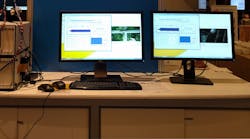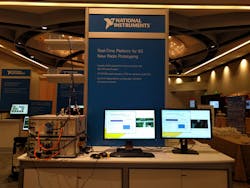Download this article in PDF format.
The activity surrounding fifth-generation (5G) networks is at a fever pitch, as proponents of the technology look to ensure that it become a reality in the not-so-distant future. Today, 5G is a hot topic at events, and receiving a great deal of scrutiny in myriad articles, webinars, etc. Those who have been paying attention are probably already aware of the benefits promised by 5G—benefits like faster data rates and greater capacity.
One tantalizing aspect of 5G concerns the prospect of over-the-air (OTA) testing. With 5G expected to utilize antenna arrays at millimeter-wave frequencies, test approaches beyond traditional cable-based methods must be investigated. That’s why a number of test-and-measurement companies, including Keysight Technologies, National Instruments, and Rohde & Schwarz, are now focusing on OTA test solutions.
At Mobile World Congress 2017, Keysight’s Lucas Hansen gave a presentation titled “mmWave Over the Air Test Challenges and Opportunities.” Check out this video on his presentation:
In it, when discussing 5G, he noted the significance of millimeter-wave frequencies along with signal bandwidths that could be as high as 1 GHz. “What this does is drive a fundamental change in the design architecture of the devices that we have,” stated Hansen.
“No longer do you have a traditional cabled environment when you are designing RF front ends,” he added. “What you now have at these frequencies is a phased-array antenna, which is bonded directly to an RF integrated circuit (RFIC). Phased-arrays are required at millimeter-waves and, as such, are introducing ‘no-connectorized test.’ That means that you no longer have the traditional cable that you once had.” Expect to hear more from Keysight regarding OTA testing in the near future.
OTA Public Demonstration
NI is another company at the forefront of OTA test solutions. At the IEEE Wireless Communications and Networking Conference (WCNC) in March, the company demonstrated a real-time OTA prototype for 5G at 28 GHz (see figure). The demonstration system, which was aligned with Verizon’s 5G specification, contained eight independently configurable 100-MHz component carriers. “The Verizon 5G demonstration system received a lot of attention and was a must-see for the WCNC attendees—which included the top wireless researchers in the world,” said James Kimery, director of marketing for RF, communications, and software-defined radio (SDR) initiatives at NI.
This demonstration system was built on Verizon’s 5G specification.
The prototype, which was built using NI’s mmWave Transceiver System, featured a new version of millimeter-wave heads operating at 28 GHz. Anokiwave and Ball Aerospace developed the phased-array antennas. Written with LabVIEW system design software, the prototype system features fully modifiable real-time code for both the base station and the user equipment. Stay tuned for more in the days to come.


